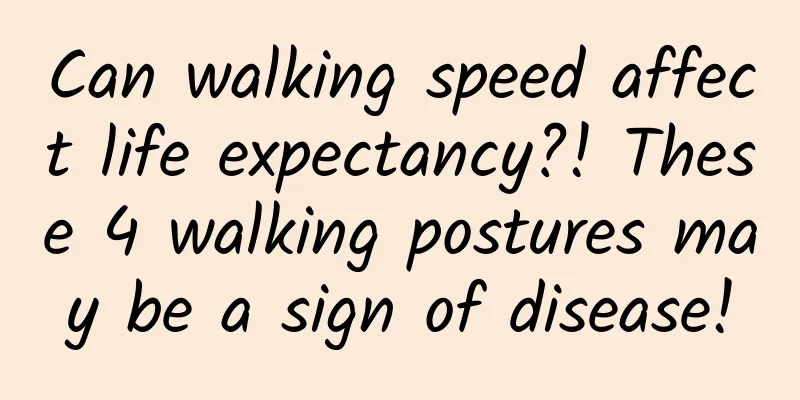Can walking speed affect life expectancy?! These 4 walking postures may be a sign of disease!

|
Walking is something we do every day and is one of the most common exercises. It is the simplest exercise but also the easiest to make mistakes. Many people are obsessed with the number of steps they walk every day, thinking that the more they walk, the better. In fact, in addition to looking at how many steps they walk every day, you also have to pay attention to how many steps you walk per minute, that is, your walking speed. Your health status can also be reflected from your walking speed! Copyright images in the gallery. Reprinting and using them may lead to copyright disputes. How can you walk faster and live longer? What other benefits does fast walking have for your health? Let's find out together~ 01 Does walking speed affect your health? Image source: Internet The Mayo Clinic Journal published a paper in 2019. The researchers monitored and studied 475,000 people for seven years on the relationship between walking speed and body mass index. The subjects regularly submitted these two data to the researchers, who estimated their life expectancy by analyzing the data model. A total of 12,800 people died in seven years. The results showed that regardless of body mass index, people who walked faster lived longer. In this study, women who walked fast were expected to live an average of 86.7 to 87.8 years, while men who walked fast were expected to live an average of 85.2 to 86.8 years. Women who walked slowly were expected to live an average of 72.4 years, while men were expected to live an average of 64.8 years. This means that people who walk fast can live about 15 to 20 years longer. 02 What other benefits does walking fast have on your body? 1. Enhance cardiopulmonary function Long-term brisk walking can enhance myocardial contractility, exercise lung function, and help prevent chronic diseases such as hypertension, hyperlipidemia, and fatty liver. 2. Reduce the risk of cancer Studies have found that insisting on brisk walking has obvious benefits for the treatment and recovery of diseases such as breast cancer, prostate cancer, and colon cancer. 3. Improve blood vessel elasticity Brisk walking can promote blood circulation and help prevent cardiovascular disease. Compared with jogging, brisk walking is more effective in controlling blood sugar in patients with prediabetes. 4. Prevent osteoporosis When walking briskly, the dual stimulation of gravity and muscle contraction can help the human body maintain bone mass, increase muscle strength and improve joint stability. Copyright images in the gallery. Reprinting and using them may lead to copyright disputes. 5. Keep in good shape When walking fast, the arm swing amplitude and strength increase, which can mobilize the muscles of the whole body to exercise together, consume more calories, and have a significant effect on improving cardiopulmonary function, bones, muscle strength, physical strength, endurance, etc., which can give the body a more comprehensive exercise. 6. Aging Slower A study published in Communications Biology pointed out that from the perspective of telomeres (telomere length is considered a key marker of biological age), maintaining a fast walking pace can make the biological age younger by up to about 16 years. After adjusting for other influencing factors, the physiological age can still be younger by up to 2 years. 03 How to walk briskly and healthily? 1. Pace: Maintain the frequency and breathe slightly when speaking Maintaining a certain frequency during walking can better improve cardiopulmonary function and achieve fitness and weight loss effects. Generally speaking, men should walk 90 to 130 steps per minute, and women should walk 80 to 120 steps per minute. You can judge by the state of talking while walking: Generally speaking, if you feel a little breathless while walking, but can talk comfortably, it means that the walking speed is moderate and has reached the standard of brisk walking. 2. Maximum heart rate: 60%~80% of (220-age) Heart rate is a simple indicator of exercise intensity and duration, generally 60% to 80% of the maximum heart rate (220-age). The recommended heart rate for elderly people is 120 to 140 beats per minute. For patients with coronary heart disease and poor heart function, brisk walking can reach 70% of the expected maximum heart rate, and continued exercise can improve heart function. Moderate-intensity brisk walking can improve cardiopulmonary function and aerobic metabolism. If you are in poor physical condition or feel unwell, you need to lower this rate. Copyright images in the gallery. Reprinting and using them may lead to copyright disputes. 3. Number of steps: 6000 steps Healthy people should walk in one go, avoid stopping and starting, and walk 6,000 steps a day. People who want to lose weight can do more. The elderly or those in poor physical condition can reduce the amount according to their own conditions. 4. Duration: more than 10 minutes If you have enough time, it is best to exercise for more than 30 minutes each time. If you can't spare a whole block of time to exercise, you can also complete it in several times, and it is best to walk continuously for more than 10 minutes each time. 5. Stride: Not too big Walking fast with big steps can easily strain the ligaments on the inside of the thigh, accelerate joint wear, and fail to improve walking speed. When walking briskly, each step should be 10 cm further forward than usual. At the beginning, you should proceed step by step and make adjustments based on your basic health conditions. 6. Location: Good air quality The air pollution in the streets is serious and not suitable for exercise. It is best to choose a park with green plants or a professional sports venue for brisk walking. 7. Warm up: Must do You can walk slowly for 5-10 minutes before brisk walking to give your body some time to adapt. Do not stop exercising suddenly for 5-10 minutes after the exercise, but gradually slow down to allow your heartbeat to gradually return to a calm state. 8. Posture: Keep your head up and your chest out When walking briskly, you should keep your head up and chest out. When swinging your arms, use your shoulder joints as the axis and swing them naturally back and forth. When landing, you can try to quickly roll your center of gravity to the forefoot with the arch of your foot after your heel lands. You can also use the midfoot or forefoot landing posture. The steps should be light when landing, and you should not be too heavy or too big. 04 Walking like this puts a strain on the body 1. Taking too big a step hurts your knees If you take too big steps when walking, the cushioning force of the soles of your feet will be reduced, which will aggravate joint damage for people with bad knee joints. If you are walking briskly, your stride can be slightly larger, but it should not affect your foot's landing. 2. Dragging your feet on the ground can hurt your arches Some people "drag" their feet on the ground when they walk, and land on the soles of their feet. This walking posture has poor cushioning and is prone to strain on joints, muscles, and arches. It is recommended to strengthen the ankle and calf strength in daily life. The simplest way is to tiptoe frequently. 3. The eight-character step wears out the joints People who are used to walking with their feet folded inwards and outwards will experience excessive wear and tear on their hip joints and knees because their points of force and impact are different from those of normal walkers. Mild "foot-folding" will not cause significant impact on the body, but if it is more serious, it requires timely adjustment or even medical treatment. 4. Back pain due to body tilt Many people do not stand straight when they walk, and they lean forward, backward, or left and right. This can easily cause back pain and affect walking speed. To change the habit of leaning when walking, you can do sit-ups to strengthen your abdominal muscles and help your body stand straighter. 05 4 abnormal walking postures or warning signs of illness 1. Indirect claudication may be caused by vascular or lumbar spinal canal disease When walking, the legs will feel sore, painful, numb or other discomforts, so that you have to stop and rest. After resting, the discomfort disappears, but the symptoms reappear when you continue walking. Clinically, this symptom is called intermittent claudication. Regardless of the cause of intermittent claudication, once the symptoms appear, it means that the disease is already serious and you should seek medical attention immediately. 2. Scissor step, beware of cerebral infarction Scissor steps are somewhat similar to bow legs. When walking, the two thighs are clamped together, the two knees are often close together, and one foot is easy to step on the instep of the other foot when walking. This may be a "signal" sent by cerebral infarction. The pathogenesis of cerebral infarction is a type of ischemic disease in which a blood vessel supplying blood to the brain tissue is completely blocked, causing brain tissue necrosis. If the brain nervous system is damaged, the muscles cannot be controlled, which naturally affects joint movement. Copyright images in the gallery. Reprinting and using them may lead to copyright disputes. 3. Penguin walk: suspect Parkinson's disease Penguin gait is walking in small, broken steps, which may be a precursor to Parkinson's disease. Because Parkinson's patients have stiff muscles and poor balance and coordination, they are prone to falling when walking. For self-protection, the body will shorten its stride to maintain body balance, so that it walks like a penguin. 4. Magnetic gait may be positive pressure hydrocephalus Magnetic gait, that is, the feet cannot be lifted up, always walking close to the ground, as if the feet are tied with magnets and walking in a magnetic field, is a typical symptom of positive pressure hydrocephalus. Hydrocephalus can easily compress nerves and blood vessels, causing abnormal gait. If a person changes from a normal step to a magnetic step in a short period of time, he must seek medical attention immediately. Review|Li Nannan Director of Hunan Science Writers Association, Deputy Director of Research and Publicity Department of Hunan Science and Technology Association, Second-level Researcher, Chinese Science Writer (Medical Field) Source: CCTV Life Circle The cover image and the images in this article are from the copyright library Reproduction of image content is not authorized |
>>: You can ski even in the hot summer. How do you achieve “snow freedom”?
Recommend
Brand promotion and marketing, how to create another Jiang Xiaobai? !
In this article, the author explains in detail wh...
How is household electricity generated? Let’s start with Faraday
We cannot live without electricity every day, and...
6 basic elements of planning a complete event
Before sharing your content, please consider the ...
Understand the 4 principles of Zhihu community operation in one article!
In August 2010, Zhihu founder and CEO Zhou Yuan, ...
What are the daily work contents of bidding and the daily work flow of Baidu bidding specialists?
For many friends who have just started SEM, they ...
Complete information flow promotion plan for 5 major industries! Take it for reference~~
Nowadays, mobile advertising is experiencing expl...
The Simplest Rule for Super Users: How to Achieve User Growth?
2018 is the second half of the Internet, and it i...
What new discoveries have been made in the scientific expedition to the Amnye Machen Glacier in Qinghai?
Recently, a research team from the Yangtze River ...
Huawei Hongmeng continues to open up: Ark JS runtime is officially open source
[[422334]] In order to survive in the gap between...
Crow Redemption: "Relationship Creation Theory" teaches you how to create relationships
Training course content: This theory is so advanc...
Analysis of Tongcheng Travel’s User Operation System
I believe everyone is familiar with Tongcheng Tra...
A "new chapter" for China's railways! my country's first unmanned heavy-haul train test was successful
Author: Shi Xiangqi and Li Chuanfu On September 2...
Decipher the marketing code behind test-type H5!
In recent years, testing H5 has become popular an...
Meizu's decisive battle in the mid-range market: the rise and fall of domestic mobile phones
Meizu has been working very hard this year. Drive...
Promotion tips in the circle of friends in the education industry!
During the Spring Festival of 2020, the outbreak ...









